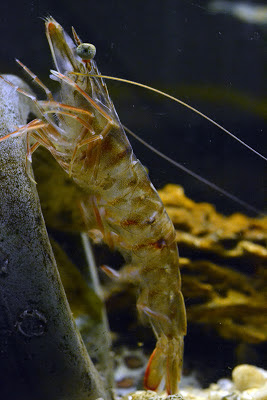The Aquarium staff here at the Virginia Living Museum recently chartered a boat to obtain a shark for our Chesapeake Bay Aquarium. We were looking for a single small - around 2-3 feet long - coastal shark that is common in our area, preferably either a
bonnethead (Sphyrna tiburo) or a
sandbar shark (Carcharhinus plumbeus).
Aquarists Patrycja Lawryniuk, myself (Sarah Peake) and Aquarium Curator Chris Crippen, all hopped on board with Captain Alan Alexander (owner of
York River Charters), who has extensive professional experience fishing this area and had been catching sharks and many other fishes for many years- so we were in good hands. Our first mission was to catch live bait (primarily
Atlantic croaker,
Micropogonias undulatus) needed to catch a shark. After a short run up the York River, we drifted over oyster beds that teemed with small craoker, each of us using a tandem bottom rig baited with squid on a light-weight bait casting rod provided by Capt. Alan. Chris was the first to catch a fish! We each caught several croaker (Chris unsurprisingly caught the most) and kept them in the live well on the boat. Once we felt we had enough bait we made our run downstream out of the York River and into the Bay.
Capt. Alan drove the boat for about 15 minutes before we reached
York Spit, where we anchored.
There were several other boats in the distance and Capt. Alan informed us that they were probably trying to catch
Cobia. We have plenty of cobia at the VLM, we needed to find a shark!
Immediately, we set our chum bucket out that we had been preparing the last couple of weeks. During food prep, we would "recycle" all of the unused fish parts into the chum bucket, add a little water here and there, and mix some larger pieces into a bloody slurry. This is a good way to attract sharks, and it was making use of every part of the fish we were already using to feed our aquariums. The 5 gallon bucket had been drilled with small hole to allow the liquid and small fish particles to drift down-current, drawing in curious and hungry sharks. We set out four lines, each baited with a live croaker on "fish finder" rigs - circle hooks on a shock leader that allows the line to slide without resistance that may alert a fish trying to take the bait. After each of the rods were anchored into slots on the sides of the boat...we waited.
 |
| Sarah and Patrycja waiting patiently for a bite |
After what felt like forever (it was actually only about 15 or 20 minutes) one of the lines began to tug. We all stood up quickly with excitement. We had agreed that I would get the first "take" or to be the one to fight the first fish. I strapped on a fish belt and locked the rod into place. With a little more effort than anticipated, I reeled the shark in.
 |
| Sarah reeling the shark in while Patrycja waits in excitement. | |
|
Once the shark was close enough to be visible from the surface, we wanted to identify the species as quickly as possible. We could see right away that it was not the species we wanted; I had caught an
Atlantic Sharpnose Shark. She was a beautiful female, about 36 inches in length and approximately 6 pounds. Although she was not the target species, we were still happy to have gotten our first catch. After quickly taking a few photos, we immediately returned her to the water. At this point, we were glad the sharks were taking the bait!
 |
| Sarah holding the first Atlantic Sharpnose! |
We casted the line back out with new bait and waited again. What felt like an even longer wait, we were all getting a little discouraged when none of the four lines were getting bites. After another few minutes, one of the lines began to tug, except not as aggressively as the first. We reeled it in only to find a 20 inch
Bluefish. He was happy to get a free meal as we threw him back into the water and casted the line back out.
After just a few more minutes one of the other lines was tugging aggressively. Patrycja was the one to pull this line in as we watched in anticipation. (Click below to watch too!)
Video of Patrycja reeling in her Atlantic sharpnose
 |
| Patrycja pulling in her catch while Alan helps her release the shark from the hook |
 |
| Patrycja with her catch! |
It was another Atlantic sharpnose! This one was another female, and a bit smaller (about 23 inches long). We were tempted to keep it, since the size was so perfect, but we stuck to our mission and threw her back in.
We had already been out on the water for about 2 hours, and everyone could see I was feeling a little seasick. With little hope in catching any other species, Chris decided to call it a day. We motored back to Yorktown shore empty handed, but with anticipation of a better catch next time. Chris and Patrycja will be back out soon and we will all keep our fingers crossed that they bring back the perfect shark. Good Luck!
By; Sarah Peake - Aquarist at the Virginia Living Museum
















































